Table of contents of
the page
 A
brief biography of the
Savva Storozhevsky (Sava Storojevski; Storojevskij, Storozevsky)
›››
A
brief biography of the
Savva Storozhevsky (Sava Storojevski; Storojevskij, Storozevsky)
›››
 A
first biography (Zitie) of the
Savva Storozhevsky (by Markell Hutynsky, 16th century) -
A
first biography (Zitie) of the
Savva Storozhevsky (by Markell Hutynsky, 16th century) -
translation on modern Russian by Konstantin Kovalev (Kovalev-Sluchevsky)
›››
 Fragments from the book about
Savva Storozhevsky (by
Konstantin Kovalev) - in Russian
›››
Fragments from the book about
Savva Storozhevsky (by
Konstantin Kovalev) - in Russian
›››
 Few words about the author of
the book - K.Kovalev (Kovalev-Sluchevsky) ›››
Few words about the author of
the book - K.Kovalev (Kovalev-Sluchevsky) ›››
 Some stories about this book,
its creation and around publication of the book
Some stories about this book,
its creation and around publication of the book
(a series "Life
of outstanding people" - ZZL) ›››
 Page with other K.Kovalev's publications on spiritual
themes
›››
Page with other K.Kovalev's publications on spiritual
themes
›››
 Some articles about
Savva Storozhevsky (and his epoch) by
Konstantin Kovalev -
in English
›››
Some articles about
Savva Storozhevsky (and his epoch) by
Konstantin Kovalev -
in English
›››
 Zvenigorod - unique city ›››
Zvenigorod - unique city ›››
___________________________________________________________________________________
"Savva Storozhevsky"
Life: facts and
myths, legends and hypotheses.
Book in
a series "Life of outstanding people"
by
Konstantin Kovalev (Kovalev-Sluchevsky)
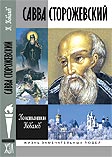
Konstantin Kovalev. Savva
Storozhevsky. Life: facts and myths, legends
and hypotheses. - M.: Molodaja Gvardia, 2007. - 416 p.:
ill.
(A series "Life of outstanding people" - ZZL:
¹ 1078.
15000 copies).
ISBN 978-5-235-03055-8
Second edition -
M.: 2008. - 416 p.:
ill. (ZZL: ¹
1098. 5000 copies).
ISBN 978-5-235-03087-9
A biography of one of the most prominent
of Russian confessor. This is a readable account of the St. Savva life,
based on scholarly research but intended for the general reader as well as
those who are already connoisseurs of Russian history. The author has
considered the various facts and myths, legends and hypotheses. In result
the author offers new datings. The majority of the known historical dates
connected to St. Savva name, demand revision and changes. The author puts
forward two ten new hypotheses. Even the text, which is published at the end
of the given page of a site, - already possible to name out-of-date.
The book is illustrated with virtually all the portraits and other pictures
surviving which relate to St. Savva life. The book reflects
Russian (Asian and European) life at the end of the 14th and in the
beginning of the 15th centuries.
The author
worked in domestic archives and libraries for collecting
materials for a spelling of the books about Savva Storozhevsky, about starting point and development of Russian
state, church and cultural life in this epoch. The
book about Savva Storozhevsky and his epoch was published in a series "Life of
outstanding people" (ZSL, mass editions - 15000 copies). Now it is the
thirst full and extensive biography, the main and capital works about the
Russian confessor.
On this page the information on Savva
Storozhevsky and around his name, also a
history of preparation and issue of the K.Kovalev’s book (and its subsequent
destiny) is collected.
_____________________________________________________________________________
Konstantin
Kovalev-Sluchevsky.
"Saint Savva and great battles of
Medieval Russia".
Moscow, Lepta, 2009. - 280 p.:
ill.
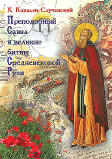 Continuation of the biography themes, new page in the biography Saint
Savva Storozhevsky, based a monastery near Moscow – unique city Zvenigorod.
Fascinating investigation of the unique events, connected to battles for
freedom from Mongol. This book about heroes of great campaigns of Russian
armies to the east. About those who inspired them on great victories.
Continuation of the biography themes, new page in the biography Saint
Savva Storozhevsky, based a monastery near Moscow – unique city Zvenigorod.
Fascinating investigation of the unique events, connected to battles for
freedom from Mongol. This book about heroes of great campaigns of Russian
armies to the east. About those who inspired them on great victories.
The book is designed for the
mass reader. It is written fascinatingly, in style peculiar to the writer,
which has already brought success to his many historical books, stories,
essays and investigations.
The
summary of publishing house to the book.
Saint Savva and great
battles of Medieval Russia / K.Kovalev-Sluchevsky. - Moscow, Lepta, 2009. -
280 p.: ill. - (5000 copies).
This book begins a series of
the editions incorporated by one main hero, which has played the major role
in Russian history. His name – Saint Savva Storozhevsky from Zvenigorod. He
lived in XIV - the beginning XV centuries, in those remarkable times after
count Dmitry Donskoy state board. Events and the facts on this book, occured
in a reality. However their singularity intriguing a sequence, sometimes
even the incredibility similar to a myth or a legend, draws today attention
not only researchers, but also everyone to whom gold pages of Russian
history are reasonably interesting.
_____________________________________________________________________________
St. Savva Storozhevsky
and Zvenigorod
“Our unremarkable northern landscapes of grassy vales have a moving
fascination, particularly close to the Russian heart. The rustic vistas have
not been blocked in our memory by either the view of Sorrento or Campagna of
Rome; nor by the frowning Alps, or the well-tilled farmlands of England. The
endless even green of our meadows is wholesome; our gently rolling land has
something peaceful, trusting and artless, defenseless and gently melancholic
about it. Something that is echoed in the Russian song, that touches a chord
in the Russian heart.” These words written once by Alexander Hertzen would
aptly describe the small and beautiful land, which has long been called
Moscow Switzerland.
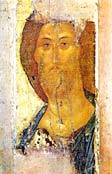
Spas
Zvenigorodsky (The Zvenigorodsky Savior or Christ the Redeemer).
Andrei
Rublev icon discovered in the Zvenigorod in 1918-1919.
Now - preserved in Tretyakov Gallery of Moscow
This land lies 60 kilometres West of Moscow and is crowned with an ancient
town with a young and sonorous name – Zvenigorod (in Russian, this means
“jingling town”). There exist quite a few legends explaining this name. Here
is one of them.
“Many years ago, there was a military outpost near the town on the hill
which is still called Storozhevoi (meaning Patrol). The guards observed the
surrounding land from a high tower which had a belfry with bells. Upon seeng
an approaching enemy, the guards sounded alarm. The tolling of the bells
reached another similar watch-tower situated nearby; and from there was
relayed to the third tower and so on, all the way to Moscow, giving warning
of the coming enemy.”
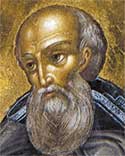
St. Savva Storozhevsky,
fresco of 19 centuries from an altar of a cathedral of Birth of Virgin
Yet another explanation also exists. The “Tale of Bygone Years” mentions
three other towns called Zvenigorod, one not far from Kiev, one in the
Ternopol Region, and the last around Galich. Of these, the most ancient town
also stood on the bank of a river. In the gurgling of the river, our
forefathers might have heard the tinkling of bells. Perhaps, the town of
Zvenigorod near Moscow, built by the Slavs who had come from Kiev and Galich,
also borrows its name from the soft murmer of the Moskva river.
The Kremlin, is situated on the western outskirts of today’s town, but it
was the centre of the ancient settlement. Since olden times till now, this
place has been called Gorodok (Little Town), it is a hill 24 metres high
with steep slopes, surrounded by deep ravines on three sides and washed by
the Moskva river on the fourth . It is not without reason that Zvenigorod is
considered to be a contemporary of Moscow. However, its early history had
been lost in the murky flow of centuries and was not mentioned in
chronicles. The first written mention of Zvenigorod appears in the testament
of the Moscow prince Ivan Danilovich Kalita, dated 1339: “And this I
bequeath to my son Ivan: Zvenigorod...”
After that, the town became the centre of a large independent principality,
a part of the Moscow principality, that is, the second town after Moscow. In
the testaments of the Moscow princes, the town was always passed to the
second son.
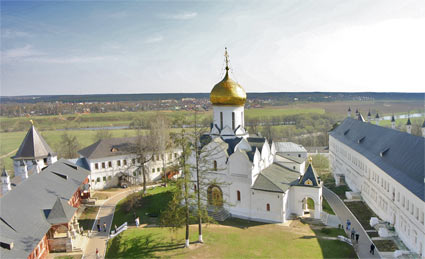
The
Savvino-Storozhevsky monastery appeared on the Storozhevoi hill to the west
of Zvenigorod.
The fortress of
the Savva monastery was thus built: the stone walls and towers were erected.
And within the walls – the czar’s palace (on the right side), a refectory, a
bell tower (clock-tower),
the
chambers of czarina Maria Miloslavskaya (on the left side).
After Dmitry Donskoy died in 1389, Zvenigorod was inherited, by tradition,
by his second son, Yury Dmitrievich. With him at the helm, the town reached
the peak of its prosperity. Of interest is the personality of this prince.
Yury was born in November, 1374, in the town of Pereyaslavl-Zalessky. Saint
Sergius Father Superior of Radonezh, who was close to the House of Grand
Duchy of Moscow (Muscovy) was his godfather. Yury was brought up in an
atmosphere of high culture and book-learning, typical of that time, but he
would not shun battle either.
The year the great battle on the Kulikovo field was fought, he was too young
– only six years old, but after becoming an apanage prince at the age of
fifteen, Yury participated in more than one campaign waged by the Moscow
princes.
During the reign of the ambitious prince Yury Dmitrievich, Zvenigorod
flourished. On the prince’s orders, a rampart was built around the Kremlin,
with a wooden wall and towers on top. In 1407, the white-stone Assumption
cathedral was erected at the centre of Gorodok. Famous icon-painters, Andrey
Rublev and Daniil Chernyi, were commissioned to work there. Trade and
handicrafts thrived. In the late 14th century, the Savvino-Storozhevsky
monastery appeared on the Storozhevoi hill to the west of Zvenigorod.
A disciple of St.Sergius of Radonez, Father Superior of the Holy Trinity
Monastery – Savva was the confessor of Prince Yury. During a visit to the
Monastery, the Prince persuaded the confessor to go with him, as the
chronicle reads, to “give blessing to his house and then to remain there and
to found a monastery in his land near Zvenigorod where there is a place
called Storozhi.” The place chosen for building the monastery was
picturesque; in the biography of St. Savva, the following is said about it.
As you love the heaven’s high paradise blooming with odoriferous flowers,
gain this place and hold it dear.”
First, a small wooden temple appeared on the site of the future monastery.
The name of the monastery, Savvino-Storozhevskii, was after the names of the
area and the first father superior. In 1399, saint Savva gave his blessing
to the military campaign of his godson against Bulgars forettlling a quick
victory over the enemy: “you’ll come back with the victory”.
The monk’s prayer was answered and the victory was granted. The small church
was then replaced by a beautiful monastery with a remarkable white-stone
Nativity cathedral in the middle. This was a truly princely present,
unprecedented in generosity; even the Trinity Monastery had no stone temples
at that time. One was built only twenty years later, in 1423, in imitation
of the Zvenigorod cathedral.
A really golden age in the history of the Savvino-Storozhevsky monastery was
during the reign of Aleksey Mikhailovich Romanov, called the “gentle”. It
became the favourite rural retreat of the Czar and acquired the highest rank
of a monastery – LAVRA. It was among the richest monasteries of Russia. In
1650, Czar Aleksey Mikhailovich issued the edict: “…at the wonder-working
Savva Storozhevsky, Nikita Mikhailovich Bobarykin together with sexton
Andrey Shakhov are hereby ordained to build, alongside the whole building ,
a 357 sazhen-long walled town of stone and rubble, with 7 towers, after the
drawing attached. The white stone rubble and lime for this czar’s town are
to be quarried and prepared in the Zvenigorod district”.
The fortress of the Savva monastery was thus built: the stone walls and
towers were erected. And within the walls – the czar’s palace, a refectory,
a clock-tower, boasting the clock that the czar had brought from the town of
Smolensk, the chambers of czarina Maria Ilyinichna Miloslavskaya and the
Holy Trinity church were built. The erection of the fraternal buildings was
started.
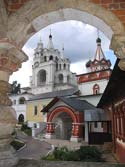
The bell tower
(clock-tower) of the Savva monastery
(boasting the
clock that the Tsar had brought from the town of Smolensk, on 1655)
The same years, the monastery bell tower, or belfry was constructed. In its
central opening, there was the famous bell that weighed about 35 tonnes and
was custom -made in 1667 by well-known craftsman Alexander Grigor’ev. Apart
from sheet copper and copper from broken bells, conventionally added to bell
metal, this bell’s cast had in it the “money copper”, that is, the copper
coins (copecks), with which the czar had earlier tried to replace silver
money, and which had been taken out of circulation after the known “copper
riot.” The loud and melodious sound of this bell could be heard far and wide
around Zvenigorod. It is not by chance that this bell was placed at the
center of the city emblem personally approved in December 1781 by Catherine
II.
For many centuries, the Savvino-Storozhevsky monastery remained a prominent
religious centre of Russia. At different times, czars Ivan the Terrible,
Fyodor Ioanovich, Mikhail Fyodorovich came to pray there, and later - czar
Peter I, crown princess Elizabeth and empress Catherine II. However, after
the boom of the mid-17th century and a relative prosperity of the 18th
century there came again hard times for the monastery.
At the end of August 1812, after the battle at Borodino, both armies – the
Russian and French were steadily advancing toward Moscow along the old
Smolensk road. The Fourth corps of Napoleon’s army branched off from the
main force in Mozhaisk and marched to Ruza, and on to Zvenigorod. “The enemy
corps is now on the Zvenigorod road... I wish to God that, smitten by
Moscow’s defenders, they met their death, should they dare to invade the
capital,” — wrote the commander-in-chief of the Russian army Mikhail
Illarionovich Kutuzov to count Fyodor Vasil’evich Rostopchin on August 30.
The squadron under brigadier general Ferdinand Fyodorovich Vincengerode,
which was sent to Zvenigorod, was confronted by French corps close to the
monastery where the French had pitched camp. The brigadier general
Vincengerode reported the following about this six hour- long battle to the
emperor Alexander: “On August 31, the viceroy attacked me in Zvenigorod. My
cossacs displayed unparalleled courage, two of their bravest field-officers
were gravely wounded; we took prisoners without losing a single man; and by
nightfall I ordered to continue our retreat”.
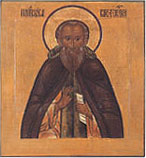
St. Savva Storozhevsky,
icon of 17 centuries
Having taken Zvenigorod in the early hours of September 1 , the French corps
split, one part remaining in the town and the other staying in the
monastery. The detachment was headed by the viceroy of Italy, the adopted
son of Napoleon Bonaparte, Eugène de Beauharnais.
In Napoleon’s Russia campaign, Prince Eugène de Beauharnais demonstrated his
brilliant military gift on many occasions. His corps won fame in the battles
near the towns of Vitebsk, Smolensk, Borodino and Maloyaroslavets and the
river Berezina. In November 1812, when Murat had departed without
permission, it was Eugène de Beauharnais who headed the remainder of the
Great Army and brought it to Magdeburg. The prince was not only a brave
warrior, he was also a wise diplomat and commander. His compatriots loved
and honoured him and his enemies respected him.
In late August 1812, this man chanced to be near Zvenigorod, at the walls of
the Savvino-Storozhevsky monastery. For six weeks, the monastery was
occupied by the French troops. The first night of their stay in the
monastery, they posted sentries around the fortress walls, to forestall a
sudden attack of cossacks. On prince de Beauharnais’order, guards were also
placed at the catherdral, yet the main church of the 15th century cloister
with the monastery’s most sacred object- Saint Savva’s relics, was laid
waste. The next day, the palace buildings, churches, monastery’s sacristy,
library and archives were also pillaged ; however, the Saint Savva relics
remained intact.
Many years later, in 1839, during the grand manoeuvres in the field of
Borodino, which were held in the memory of the famous battle, the duke
Maksimilien Leuchtenberg, the son of prince Eugène de Beauharnais related to
count Novosiltsev, the adjutant of Moscow military governor, what had really
happened in the Savvino-Storozhevsky monastery. When speaking of the battle
of Borodino and of the campaign of 1812 in general, the duke asked
Novosiltsev where the monastery of Saint Savva was and how far it was from
Moscow. This question from a person who had never been to Russia surprised
Novosiltsev. He answered that there was nothing in the monastery that could
be of interest to his Highness. But the duke smiled and replied: “You are
probably surprised that I know about the monastery of Saint Savva, although
there is nothing remarkable in it. You would be surprised even more when I
say that I, a catholic, wish to bow to yours Saint Savva. I promised this to
a man on his deathbed, - my father. Would you like to know why he demanded
this of me? Well, my father, prince Eugène, as you probably know, was in
Napoleon’s army during his Russian campaign ,and he headed the corps that
consisted of Frenchmen and Italians. One morning my father was informed that
a Russian squadron was spied near Zvenigorod. He immediately ordered the
advance guard of his corps to set out for this place with artillery support.
He himself went with the troops, as he wanted to examine in detail the
suburbs of Moscow. After about 10 miles on the move, he left his troops
camped near a monastery, while he together with his escort and some generals
went into the monastery to bed down in the cells. It was already about 10
p.m. He said he couldn’t remember whether he was awake or dreaming, but he
saw the door open and a man in long black clothes enter the room stepping
quietly. The man came up to him so close that he was able to discern his
face in the moonlight. An old beard face. He stood there for about a minute
as if examining the prince and finally he said in a low voice:
“Don’t let your men plunder the monastery and above all take anything out of
the church. If you do as I ask, God’s grace will be with you and and you’ll
return to your fatherland safe and sound”.
Having said this, the old man quietly left the room. The prince, woke up
early in the morning, Immediately he called the adjutant and told him to
order the troops to prepare for a march back to Moscow. He let the adjutant
go and went to see the church. Entering it, he saw a tomb and an icon. The
face had a striking resemblance to the old man he had seen in the night.
This was the face of Saint Savva. The prince bowed reverently to the saint’s
relics. After this event, he fought in almost all the battles beginning from
Maloyaroslavets, during the retreat of the French Army from Russia and later
in the campaign of 1813 in Germany. In none of the battles was the Prince
wounded; the words of the old monk came true: he returned unscathed to his
fatherland, and even after Napoleon’s fall, he remained loved and
respected”.
Fifteen years after the death of Eugène de Beauharnais, duke Maksimilien
Leuchtenberg fulfilled the will of his father: he did not fail to visit the
St. Savva monastery and to bow before his relics.
In the 19 century, Zvenigorod’s beautiful landscapes and climate, made it
popular among Moscow noblemen, merchants, celebrated writers, artists, and
musicians who spent the summer there. This place was visited by Levitan,
Chekhov, Taneev, Shalyapin, Glazunov, Richter and Prishvin. There were more
country estates of prince and count families near Zvenigorod than in other
areas around Moscow; they numbered about 200 in the early 19th century. Now
there are 27 of these, some of them, for example, Korallovo or Vvedenskoe,
are almost fully intact.
At the end of October, 1941, the German army was able to break the Mozhaisk
defence line. On October 25, the enemy occupied the town of Ruza. In
operations there appeared a new term, the Zvenigorod direction. The defence
of Zvenigorod was launched. The 144th rifle division headed by Major-General
Mikhail Andreevich Pronin was sent there. The Nazi troops preparing for an
offensive on Zvenigorod were pounded by a hail of mortar and artillery fire.
The city itself was in the state of siege since October 20. The whole adult
population of the frontline town was building fortifications.
Side by side with Red Army soldiers, the people of Zvenigorod dug trenches,
set up strong points and hedgehog defence; explosives were planted in all
large public buildings and electric power stations to be set off if
necessary. The 23d Zvenigorod battalion also prepared for the battle, and
partisan groups were formed.
“December 1 to 4 were the hardest days for us. On these days the German
headquarters undertook an outflanking maneuver in to the
“double-pincer”movement. The first pincer was to close at Kubinka and the
second one – at Golitsyno via Zvenigorod. In the morning of December 2, the
enemy was only 2 kilometres from the town. To stall a sudden breakthrough, a
so-called fire barrage was put up on the northern outskirts: it was a
barrier of fallen trees and logs with a large number of bottles with the
motor cocktail inside. A group of soldiers standing duty near the barrage
had to set fire to it on seeing the enemy approach. Only towards the evening
of the 3rd of December, was the danger of small or big pincer eliminated.
To the east of Zvenigorod, the German troops were stopped a mere 25 km from
Moscow and 10 km from the Western front headquarters in the village Vlasikha.
The Germans announced the capture of Zvenigorod twice: at the height of the
November offensive in the leaflets and on December 2 on the radio. However,
the German propaganda was a bit hasty. On December 6 in the morning, the
Russian army launched a counter-offensive on the right flank of the Western
front. By December 20, the whole Zvenigorod region was free.
The war was rolling west and the Moscow Switzerland began a slow return to a
peaceful life. In the late 1940s, holiday-makers moved again to Zvenigorod.
But not only tourists were attracted by the salubrious air, and landscapes,
the climate and the ancient history of this land.
Back at the turn of the 20th century a biological station of the Moscow
State University’s Department of Biology was founded near Zvenigorod. Its
history dates back to 1908, when on the grounds of Upper cottages, a student
of the Department of Physics and Mathematics of Moscow University, and later
professor Sergei Nikolaevich Skadovsky, built, with his own money a
laboratory to study the freshwater organisms in their natural environment.
In 1934, the biostation was handed over to Moscow State University. In
recent years, senior and post-graduates students of the Departments of
Geology, Geography and Physics also work there together with biologists.
There are lots of places on Earth that can be rightly proud of their ancient
history; there are many that are rare examples of primeval and perfect
beauty. Zvenigorod is a unique land where hoary antiquity slumbers framed by
beautiful landscapes; where the past meets the present, and where Nature
benevolently smiles on people.
Today, almost two hundred years on , the words written about Zvenigorod by
the famous Russian historian Nikolai Mikhailovich Karamzin, are still true:
“Nowhere have I seen such a diversity of plants; the flowers, grass and
trees are full of a special strength and freshness; the lime-trees and
oak-trees are splendid; the road from here to Moscow is most pleasing to the
eye ; it is hilly, but ‘behold the vistas’!”
Broadcasting Company ”The Voice of Russia”
(text)
ALL RUSSIA. Encyclopedia from A to Z
K. Kovalev (Illustrations and comments)
The main themes of this
page:
Savva Storozhevsky, Savva,
Pushkin, Zvenigorod, Andrey Rublev, Eugene Bogarne, Andrey Tarkovsky, Sava,
Savvino-Storozhevsky monastery, Timur, Tamerlane, Storojevskij, Storojevski,
Storozevsky, Gorodok, Russian sacred, Yury Dmitrievich, Alexey Mikhailovich
Romanov, Maria Miloslavskaya, Dmitry Donskoy, Storozhi, Lavra, Eugene de
Beauharnais, Josephine de Beauharnais, Levitan, Chekhov, Taneev, Shalyapin,
Glazunov, Richter, Prishvin, Switzerland near Moscow.
